Bb4.2
There is no limit for chains of associations, they are
'boundless' → Aditi.
In my idiom an association is indicated by an arrow.
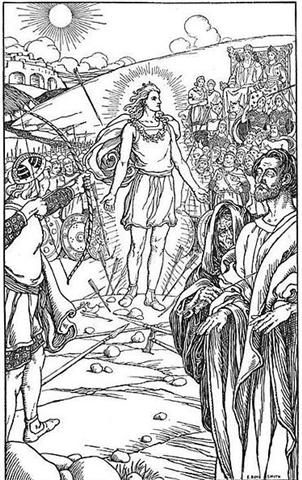
But chains of associations will - if correct -
always (sooner or later) return to their points of origin, viz. by way of their navel
cords (pito)
connecting them with Mother Earth -
ki te pito o te henua - i.e. grounding them.
|
 |
|
Bb3-41 (540
= 3 * 180) |
| mai tae vere
hia -
ki te pito o te henua |
... 4 March 1779. The British ships
are again at Kaua'i, their last days in the
islands, some thirteen months since their initial visit.
A number of Hawaiian men come on board and under the
direction of their women, who remain alongside in the
canoes, the men deposit navel cords of newborn children
in cracks of the ships' decks (Beaglehole 1967:1225).
For an analogous behavior observed by the missionary
Fison on the Polynesian island of Rotuma, see
Frazer (1911, 1:184). Hawaiians are connected to
ancestors (auumakua), as well as to living
kinsmen and descendants, by several cords emanating from
various parts of the body but alike called piko,
'umbilical cord'. In this connection, Mrs. Pukui
discusses the incident at Kaua'i: I have seen
many old people with small containers for the umbilical
cords... One grandmother took the cords of her four
grandchildren and dropped them into Alenuihaha
channel. 'I want my granddaughters to travel across the
sea!' she told me. Mrs. Pukui believes that the
story of women hiding their babies' pikos in
Captain Cook's ship is probably true. Cook was first
thought to be the god Lono, and his ship his
'floating island'. What woman wouldn't want her baby's
piko there? (Pukui et al. 1972, 1:184)
...
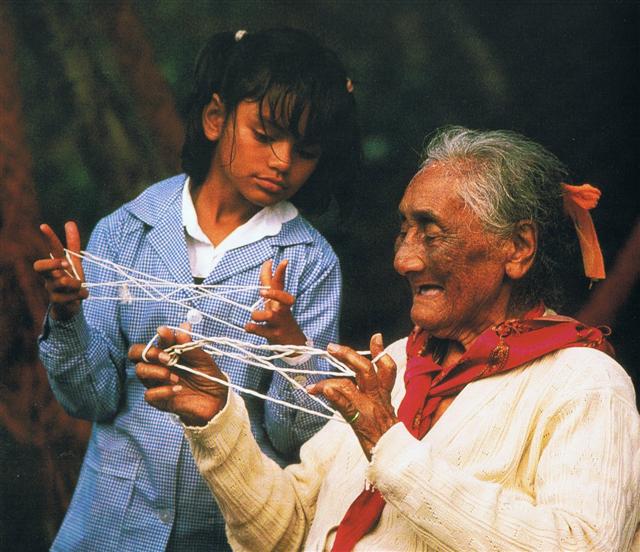
Piko. 1. To
twist (vi); twisted, bent;
haga piko, bend formed
by part of the coast. 2. To hide (vi); hidden; kahi
piko, tuna fish meant as a gift for someone, and
which is kept hidden away from others. 3. Slip knot
(used with fishing lines). Vanaga. 1. Post; moa tara
piko, cock with long spurs. 2. Crooked, tortuous;
piko mai piko atu, sinuosity; hakapiko,
pliant, to bend; pikopiko, crooked; hoe
pikopiko, pruning knife; veo pikopiko, arrow
that flies ill. 3. To hide oneself, to lie in wait, to
set a trap, to take refuge, to withdraw, to beat a
retreat, security, ambush, padlock; piko reoreo,
false security; piko etahi, to withdraw one after
another; pikoga, asylum, receptacle, refuge,
retreat, snare. Churchill. H. Piko Umbilical
cord. Hawaiians are connected to ancestors (aūmakua),
as well as to living kinsmen and descendants, by several
cords emanating from various parts of the body but alike
called piko, 'umbilical cord'. Islands of
History. H. Piko 1. Navel, navel string,
umbilical cord. Fig. blood relative, genitals. Cfr
piko pau 'iole, wai'olu. Mō ka piko, moku
ka piko, wehe i ka piko, the navel cord is cut
(friendship between related persons is broken; a
relative is cast out of a family). Pehea kō piko?
How is your navel? (A facetious greeting avoided by some
because of the double meaning.) 2. Summit or top of a
hill or mountain; crest; crown of the head; crown of the
hat made on a frame (pāpale pahu); tip of the
ear; end of a rope; border of a land; center, as of a
fishpond wall or kōnane board; place where a stem
is attached to the leaf, as of taro. 3. Short for
alopiko. I ka piko nō 'oe, lihaliha (song),
at the belly portion itself, so very choice and fat. 4.
A common taro with many varieties, all with the leaf
blade indented at the base up to the piko,
junction of blade and stem. 5. Design in plaiting the
hat called pāpale 'ie. 6. Bottom round of a
carrying net, kōkō. 7. Small wauke
rootlets from an old plant. 8. Thatch above a door.
'Oki i ka piko, to cut this thatch; fig. to dedicate
a house. Wehewehe.
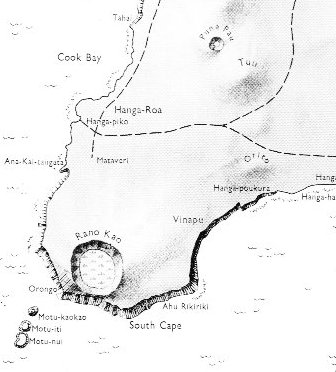
 |
 |
 |
|
Bb3-38 (537 =
542 - 5) |
Bb3-39 |
Bb3-40 (118 =
4 * 29½) |
|
ma to kava - kua huri te hatu |
ki te henua |
ma te maitaki |
|
... In Hindu
legend there was a mother goddess called
Aditi, who had seven offspring. She is
called 'Mother of the Gods'. Aditi, whose
name means 'free, unbounded, infinity' was
assigned in the ancient lists of constellations
as the regent of the asterism Punarvasu.
Punarvasu is dual in form and means 'The
Doublegood Pair'. The singular form of this noun
is used to refer to the star Pollux. It is not
difficult to surmise that the other member of
the Doublegood Pair was Castor. Then the
constellation Punarvasu is quite
equivalent to our Gemini, the Twins. In far
antiquity (5800 BC) the spring equinoctial point
was predicted by the heliacal rising of the
Twins ...
Maitaki.
Clean, neat, pure, pretty, nice, beautiful,
handsome; tagata rima maitaki,
clean-handed man, correct man. Vanaga. 1. Good.
Henua maitaki = the good earth. 2. Shine.
Marama maitaki = the shining moon.
Barthel. Ce qui est bon. Jaussen according to
Barthel. Meitaki, good, agreeable,
efficacious, excellent, elegant, pious, valid,
brilliant, security, to please, to approve (maitaki);
ariga meitaki, handsome, of pleasant
mien; mea meitaki ka rava, to deserve;
meitaki ke, marvelous, better.
Hakameitaki, to make good, to amend, to do
good, to bless, to establish. Meitakihaga,
goodness. PS Pau.: maitaki, good. Mgv.:
meitetaki, beautiful, good. Mq.:
meitai, good, agreeable, fit, wise,
virtuous. Ta.: maitaiki, good, well.
Niuē: mitaki, good. Maitakia,
clean. Churchill. |
|
Nov 22 |
23 (327) |
24 |
|
YED POSTERIOR (Hand Behind) =
ε
Ophiuchi,
RUKBALGETHI SHEMALI (Northern Knee of the Giant)
=
τ
Herculis
(246.6).
δ
Apodis (246.7),
ο
Scorpii (246.8) |
Heart-5 (Fox)
σ
Scorpii
(247.0),
HEJIAN =
γ
Herculis
(247.2),
ψ
Ophiuchi (247.7) |
ρ
Ophiuchi (248.1),
KAJAM (Club) =
ω
Herculis
(248.3),
χ
Ophiuchi (248.5),
SHE LOW (Market Tower) =
υ
Ophiuchi,
Tr.
Austr. (248.7), ζ Tr. Austr. (248.8) |

... Proclus informs us that
the fox star nibbles continuously at the thong
of the yoke which holds together heaven and
earth; German folklore adds that when the fox
succeeds, the world will come to its end. This
fox star is no other than Alcor, the
small star g near zeta Ursae Majoris (in India
Arundati, the common wife of the Seven
Rishis, alpha-eta Ursae ... |
|
RIGHT
ASCENSION LINES AT THE FULL MOON: |
|
Al Dabarān-2 (The
Follower)
HYADUM I =
γ
Tauri (63.4)
*22.0 = *63.4 - *41.4 |
HYADUM II = δ¹ Tauri
(64.2) |
Net-19 (Crow)
AIN (Eye) =
ε
Tauri,
θ¹
Tauri,
θ²
Tauri (65.7) |
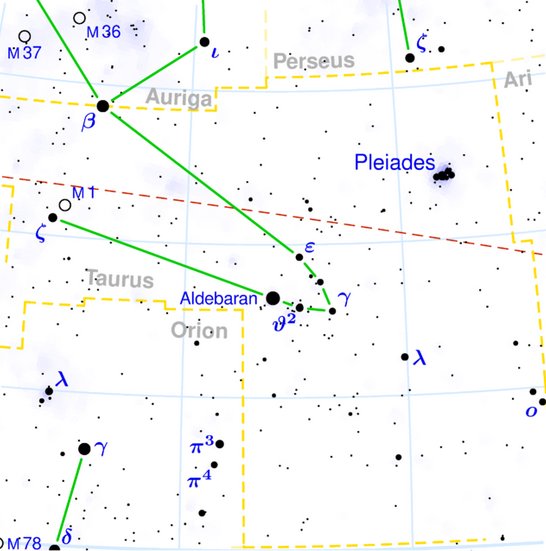 |
|
... There was no water in the
village. The lakes and rivers were dry. Raven
and Crow, two young girls who were having their
first menstrual courses, were told to go and
draw water from the ocean. Finding the journey
too long, Raven decided just to urinate into her
basket-bucket. She decieved no one and was
severly scolded. Crow returned much later but
with drinking water. As a punishment, Raven was
condemned never to find water in the summer;
only in winter would she find something to
drink. For that reason the Raven never drinks
during the hot months; she speaks with a raucous
voice because of her dry throat ... |
 |
 |
 |
|
Bb3-41 (540 = 3 * 180 =
175 + 365) |
Bb3-42
(541 - 421 = 120) |
Bb3-43
(542 = 177 + 365) |
|
mai tae vere
hia - ki
te pito o te henua |
e nuku hoi |
kua here te toa - i ruga
o to maro |
|
Vere.
1. Beard, moustache (vede G);
vere gutu, moustache; verevere,
shaggy, hairy, tow, oakum. Mgv.: veri,
bristly, shaggy, chafed (of a cord long in
use). Mq.: veevee, tentacles. Ta.:
verevere, eyelash. 2. To weed (ka-veri-mai,
pick, cut-grass T); verevere, to
weed. P Mgv.: vere, to weed. Mq.:
veéveé, vavee, id. 3. Verega,
fruitful, valuable; verega kore,
unfruitful, valueless, contemptible, vain,
futile, frivolous; tae verega,
insignificant, valueless; mataku verega
kore, scruple. Mgv.: verega, a
design put into execution; one who is apte,
useful, having a knowledge how to do things.
4. Ta.: verevere, pudenda muliebria.
Ma.: werewere, id. (labia minora).
Churchill. Sa.: apungaleveleve,
apongaleveleve, a spider, a web. To.:
kaleveleve, a large spider. Fu.:
kaleveleve, a spider, a web. Niuē:
kaleveleve,
a cobweb. Nukuoro: halaneveneve,
a spider. Uvea: kaleveleve,
a spider. Mgv.: pungaverevere,
a spider. Pau.: pungaverevere,
cloth. Mg.: pungaverevere,
a cobweb. Ta.: puaverevere,
id. Mao.: pungawerewere,
puawerewere,
puwerewere,
a spider. Ha.: punawelewele,
a spider, a web. Mq.: pukaveevee,
punaveevee,
id. Vi.: lawa,
a fishing net; viritālawalawa,
a cobweb; butalawalawa,
a spider. Churchill 2.
Pito.
1. Umbilical cord; navel; centre of
something: te pito o te henua, centre
of the world. Ana poreko te poki, ina ekó
rivariva mo uru ki roto ki te hare o here'u
i te poki; e-nanagi te pito o te poki, ai
ka-rivariva mo uru ki roto ki te hare,
when a child is born one must not enter the
house immediately, for fear of injuring the
child (that is, by breaking the taboo on a
house where birth takes place); only after
the umbilical cord has been severed can one
enter the house. 2. Also something used for
doing one's buttons up (buttonhole?).
Vanaga. Navel. Churchill. |
|
Nov 25 → 9 * 25 = 225 |
26 (330) |
27 |
|
Al Kalb-16 (The Heart)
/
Jyeshtha-18 (Eldest)
/
ANA-MUA-1 (Entrance
pillar)
ANTARES = α Scorpii
(249.1),
MARFIK (Elbow) = λ Ophiuchi,
φ Ophiuchi (249.5), ω Ophiuchi (249.8) |
γ Apodis (250.1), σ Herculis (250.3), θ Tr.
Austr. (250.6),
τ Scorpii
(250.7) |
HAN = ζ Ophiuchi
(251.0) |
|
... In China, with
Capricornus, Pisces, and a part of
Sagittarius, it [Aquarius] constituted the
early Serpent, or Turtle, Tien Yuen;
and later was known as Hiuen Ying,
the Dark Warrior and Hero, or Darkly
Flourishing One, the Hiuen Wu, or
Hiuen Heaou, of
the Han dynasty, which Dupuis gave as
Hiven Mao. It was a symbol of the
emperor Tchoun Hin, in whose reign
was a great deluge; but after the Jesuits
came in it became Paou Ping, the
Precious Vase. It contained three of the
sieu, and headed the list of zodiac signs as
the Rat, which in the far East was
the ideograph for 'water', and still so
remains in the almanacs of Central Asia,
Cochin China, and Japan ...

|
|
Egyptian sticks |
 |
Phoenician
taw |
 |
Greek chi |
Χ (χ) |
|
Greek tau |
Τ (τ) |
|
In Plato's
Timaeus, it is explained
that the two bands that form the
soul of the world cross each
other like the letter Χ.

Roman XII = 12 → XIII = 13, with
the Nose in between - and later,
after the Mouth, the cycle would
begin anew (I).
Chi or X is
often used to abbreviate the
name Christ, as in the holiday
Christmas (Xmas). When fused
within a single typespace with
the Greek letter Rho, it is
called the labarum and used to
represent the person of Jesus
Christ. (Wikipedia)

... tau
is the 19th letter of the Greek
alphabet. In the system of Greek
numerals it has a value of 300
... Taw is believed to be
derived from the Egyptian
hieroglyph meaning 'mark' ...
Taw,
Tav or Taf is the
twenty-second and last letter in
many Semitic abjads ... In
gematria Tav represents
the number 400, the largest
single number that can be
represented without using the
Sophit forms ...
'From Aleph
to Taf' describes
something from beginning to end;
the Hebrew equivalent of the
English 'From A to Z' ...
Tav is
the last letter of the Hebrew
word emet, which means
truth. The midrash explains that
emet is made up of the
first, middle, and last letters
of the Hebrew alphabet (Aleph,
Mem, and Tav...).
Sheqer (falsehood), on
the other hand, is made up of
the 19th, 20th, and 21st (and
penultimate) letters.
Thus, truth is
all-encompassing, while
falsehood is narrow and
deceiving. In Jewish mythology
it was the word emet that
was carved into the head of the
Golem which ultimately
gave it life. But when the
letter 'aleph' was erased from
the Golem's forehead,
what was left was 'met' -
dead. And so the Golem
died ... (Wikipedia)

|
|
|
RIGHT
ASCENSION LINES AT THE FULL MOON: |
|
No star listed (66) |
No star listed (67) |
Rohini-4 (The Red One)
/
Pidnu-sha-Shame-4
(Furrow of Heaven)
/
ANA-MURI-2 (Rear pillar - at the foot of
which was the place for tattooing)
ALDEBARAN (The Follower) = α Tauri
(68.2),
THEEMIN = υ² Eridani
(68.5) |
|
May 26 |
27 (80 +
67 = 147) |
28 (148 =
225 - 77) |
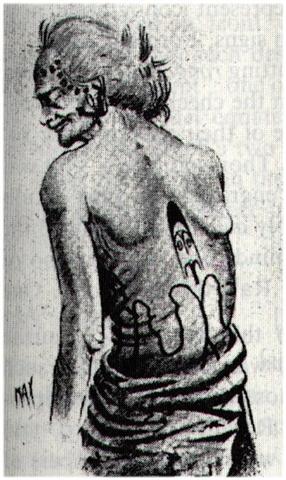 |
Also the Furrow of Heaven was 'crooked' (piko):
... As a kind of proof I will offer the resemblance
between glyph number 542 and the Pithagorean letter:
Epimenides stated that all Cretans lied,
which was an example of curved (unbounded,
infinite) logic, because he himself was a
Cretan. This was the opposite of the
straightforward linear logic at the other side
of the coin - the kind we in the industrialized
western culture have entangled ouselves in.
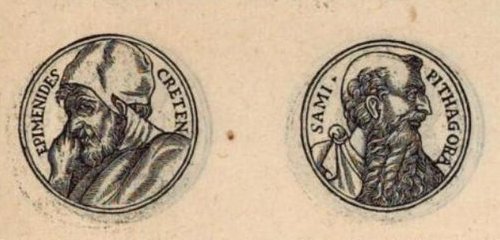
... They go inland at the land.
The child nursed and tended grows up, is able to go
and play. Each day he now goes off a bit further
away, moving some distance away from the house, and
then returns to their house. So it goes on and the
child is fully grown and goes to play far away from
the place where they live. He goes over to where
some work is being done by a father and son.
Likāvaka is the name of the father - a
canoe-builder, while his son is Kiukava.
Taetagaloa
goes right over there and steps forward to the stern
of the canoe saying - his words are these: 'The
canoe is crooked.' (kalo ki ama).
Instantly Likāvaka is
enraged at the words of the child. Likāvaka
says: 'Who the hell are you to come and tell me that
the canoe is crooked?'
Taetagaloa replies:
'Come and stand over here and see that the canoe is
crooked.' Likāvaka goes over and stands right
at the place Taetagaloa told him to at the
stern of the canoe. Looking forward, Taetagaloa
is right, the canoe is crooked. He slices through
all the lashings of the canoe to straighten the
timbers. He realigns the timbers. First he must
again position the supports, then place the timbers
correctly in them, but Kuikava the son of
Likāvaka goes over and stands upon one support.
His father Likāvaka rushes right over and
strikes his son Kuikava with his adze.
Thus Kuikava dies.
Taetagaloa goes over
at once and brings the son of Likāvaka,
Kuikava, back to life. Then he again aligns the
supports correctly and helps Likāvaka in
building the canoe. Working working it is finished
...
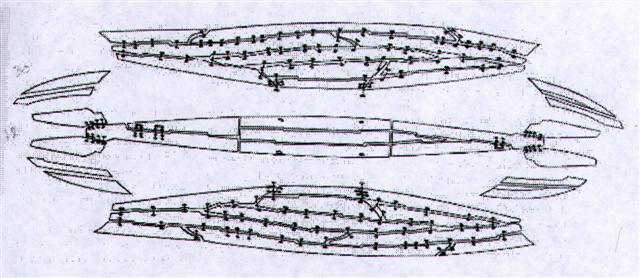
The beginning of the B text was
evidently located with the Full Moon on the brink of the bridge
across the Milky Way at the constellation of Auriga, with
ε (Al-maaz,
the Male Goat) at a place corresponding to MARCH 31 (90)
according to the Golden Age of the Bull (*64 right ascension
days earlier than my assumed era for rongorongo):
 : :
... Ogotemmêli had his own ideas about
calculation. The Dogon in fact did use the decimal system,
because from the beginning they had counted on their fingers,
but the basis of their reckoning had been the number eight and
this number recurred in what they called in French la
centaine, which for them meant eighty. Eighty was the limit
of reckoning, after which a new series began. Nowadays there
could be ten such series, so that the European 1,000
corresponded to the Dogon 800. But Ogotemmêli believed that in
the beginning men counted by eights - the number of cowries on
each hand, that they had used their ten fingers to arrive at
eighty, but that the number eight appeared again in order to
produce 640 (8 x 10 x 8). 'Six hundred and forty', he said, 'is
the end of the reckoning.' According to him, 640 covenant-stones
had been thrown up by the seventh Nummo to make the outline in
the grave of Lébé ...
And after 1½ years = 3 * 175 = 3 * 7 * 25 = 21 * 25 (= 5 * 105) right ascension days the Full Moon
would then be found on the other side of the Milky Way at the
bridge of Perseus 525 (=
350
+ 175) glyphs later:
.jpg)
|
VISIBLE CLOSE TO
THE FULL MOON |
|
In OCT 1 (274 =
91 + 183): |
*25 |
In SEPT 6 (249 =
66 + 183): |
|
the place of
APRIL 1 (91) |
the place of
MARCH 5 (66) |
|
June 4 (91 + 64 =
155) |
May 12 (130 = 66 +
64) |
|
 |
 |
|
Ba1-1 |
Bb3-25 (421
+ 103 = 414 + 110) |
|
HAEDUS II (*75) |
ALGENIB PERSEI
(*50) |
|
"April 24 (114 =
91 + 23) |
"March 30 (89 =
66 + 23) |
|
524 =
160 +
364 =
414 (→ Bharani) + 110 = 314 +
420 / 2 |
|
... About
Carmenta we know from the historian Dionysus
Periergetis that she gave orcales to Hercules and
lived to the age of 110 years. 110 was a canonical
number, the ideal age which every Egyptian wished to
reach and the age at which, for example, the
patriarch Joseph died. The 110 years were made up of
twenty-two Etruscan lustra of five years
each; and 110 years composed the 'cycle' taken over
from the Etruscans by the Romans. At the end of each
cycle they corrected irregularities in the solar
calendar by intercalation and held Secular Games.
The secret sense of 22 - sacred numbers were never
chosen haphazardly - is that it is the measure of
the circumference of the circle when the diameter is
7. This proportion, now known as pi, is no
longer a religious secret; and is used today only as
a rule-of-thumb formula, the real mathematical value
of pi being a decimal figure which nobody has
yet been able work out because it goes on without
ever ending, as 22 / 7 does, in a neat recurring
sequence [3.142857142857 ...]. Seven lustra add up
to thirty-five years, and thirty-five at Rome was
the age at which a man was held to reach his prime
and might be elected Consul. (The same age was fixed
upon by a Classically-minded Convention as the
earliest at which an American might be elected
President of the United States.) ... |
From Al-gol at the Full Moon up to and including
Al-genib there were 6 days:
 |
 |
 |
 |
 |
 |
 |
|
Bb3-19 |
Bb3-20 → 320 |
Bb3-21 (520) |
Bb3-22 (100) |
Bb3-23 |
Bb3-24 |
Bb3-25 (524) |
|
E tagata hakatu ki to ika e
vaha te ika |
ma te ua |
kua pua te hahine |
kua tere ko to haga |
ki te tagata haga
|
ki tona
mea ke - kua oho koia ki te haga |
mai moe koia ki te mago -
kua haga i tona mea ke |
|
RIGHT
ASCENSION LINES AT THE FULL MOON: |
|
MENKAR (The Nose) =
α
Ceti
(44.7) |
3h (45.7)
GORGONEA TERTIA =
ρ
Persei
(45.1),
ALGOL (The Demon)
=
β
Persei
(45.9) |
ι
Persei (46.1),
MISAM (Next to the Pleiades) =
κ
Persei
(46.2),
GORGONEA QUARTA =
ω
Persei
(46.7),
BOTEIN (Pair of Bellies) =
δ
Arietis
(46.9) |
ζ Arietis
(47.7) |
ZIBAL (Young Ostriches)
=
ζ
Eridani (48.0),
κ
Ceti (48.9) |
τ Arietis
(49.7) |
ALGENIB PERSEI = α Persei (50.0),
ο Tauri (50.2), ξ Tauri (50.8)
GIENAH (γ Corvi) |
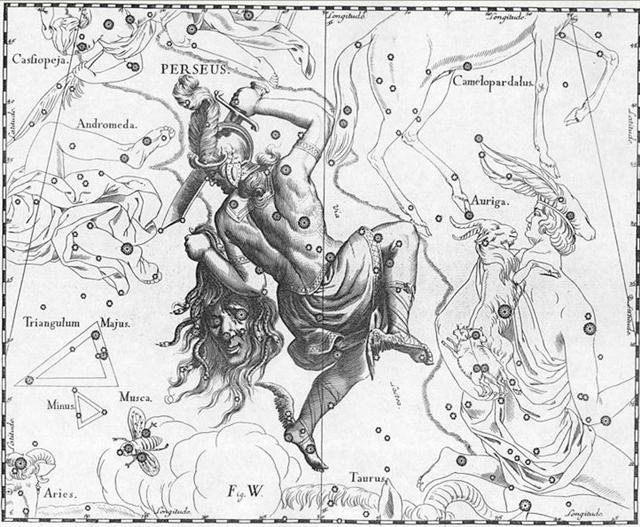 |
|
RIGHT
ASCENSION AT THE SUN: |
|
Nov 3 |
4 |
5 |
6 (310) |
7 |
8 |
9 |
|
ω
Bootis (227.2),
NEKKAR (Herdsman) = β Bootis
(227.3),
σ
Librae (227.5),
π²
Oct.
(227.7),
NADLAT (Mean Little Ones) = ψ Bootis
(227.8), π Lupi (227.9) |
15h (228.3)
ZUBEN HAKRABIM = ν Librae
(228.3), λ Lupi (228.9) |
ω
Oct. (229.3),
ι
Librae (229.6),
κ
Lupi (229.7),
ζ
Lupi (229.8) |
Al Zubānā-14b (Claws)
χ
Bootis (230.3),
PRINCEPS =
δ
Bootis
(230.6),
ZUBEN ELSCHEMALI (Northern Claw) =
β
Librae
(230.8) |
μ
Lupi,
γ
Tr. Austr.
(231.3), ο Librae (231.8) |
ο
Cor. Borealis (232.0),
δ
Lupi (232.1),
φ¹,
ν²
Lupi (232.2),
ν¹
Lupi (232.3),
ε
Lupi (232.4),
φ²
Lupi (232.5),
PHERKAD (The Dim One of the Two Calves) =
γ
Ursae Min.
(232.6),
ε
Librae (232.7),
η
Cor. Borealis (232.8),
υ
Lupi (232.9)
*191.0 = *232.4 - 41.4 |
ALKALUROPS (The Herdsman's Lance) =
μ
Bootis
(233.1),
ED ASICH (Male Hyena) =
ι
Draconis
(233.2) |
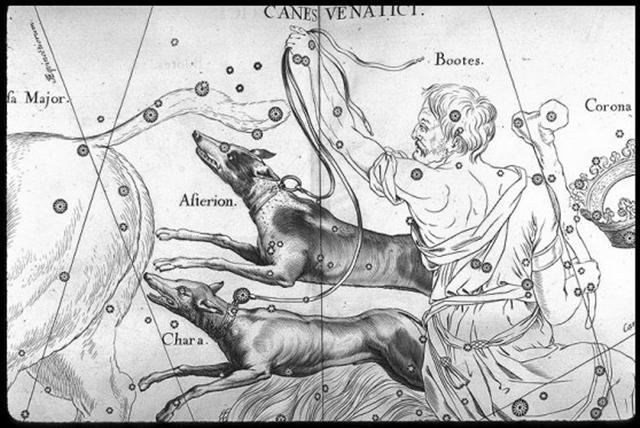 |
|
*44 = *409 |
*410 |
*411 |
*412 |
*48 = *413 |
→
BHARANI |
*50 |
|
May 4 |
5 (125 = 5 * 25) |
6 |
7 |
8 (2 * 64) |
9 |
10 (130) |
|
"March
24 |
25 (125 - 41) |
26 |
27 |
28 |
29 (88) |
30 |
And from the Breast of Cassiopeia (te hipu) culminating at
21h in November 18 (322),
 |
 |
|
Bb3-33 (111 = 2 *
266 - 421) |
Bb3-34 (13 * 41 =
542 - 9 = 168 + 365) |
|
mai tae tu |
ki te hipu |
|
Hipu. Calabash, shell, cup,
jug, goblet, pot, plate, vase, bowl, any such
receptacle; hipu hiva, melon, bottle; hipu
takatore, vessel; hipu unuvai,
drinking glass. P Mgv.: ipu, calabash, gourd
for carrying liquids. Mq.: ipu, all sorts of
small vases, shell, bowl, receptacle, coconut shell.
Ta.: ipu, calabash, cup, receptacle.
Churchill.
 |
|
Nov 17 |
18 (322) |
|
Iklīl al Jabhah-15 (Crown of
the Forehead) /
Anuradha-17 (Following Rādhā)
/
Room-4 (Hare)
ξ
Lupi,
λ
Cor. Bor.(241.1),
ZHENG =
γ
Serpentis,
θ
Librae (241.2),
VRISCHIKA =
π
Scorpii
(241.3),
ε
Cor.
Borealis (241.5),
DSCHUBBA
(Front of Forehead) = δ Scorpii
(241.7), η Lupi (241.9) |
υ
Herculis (242.3),
ρ
Cor. Borealis (242.4),
ι
Cor. Borealis (242.5),
θ
Draconis (242.6),
ξ
Scorpii (242.7)
SCHEDIR
(Breast) α Cassiopeiae
*201.0 = *242.4 - *41.4 |
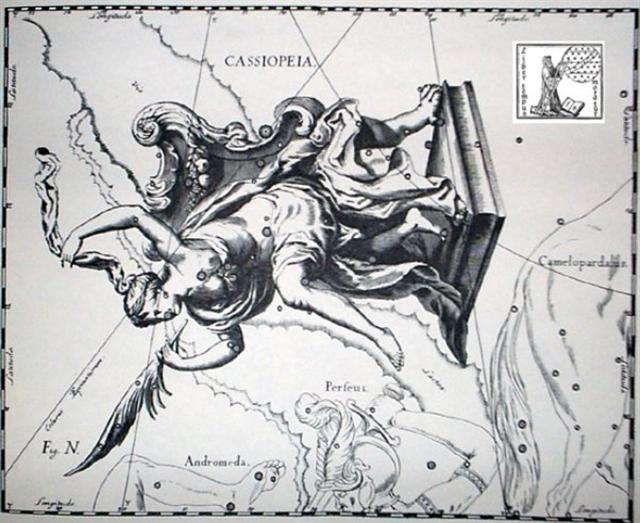 |
|
RIGHT ASCENSION
LINES AT THE FULL MOON: |
|
ZAURAK (Boat) = γ Eridani
(58.9) |
λ Tauri (59.3), ν Tauri (59.9) |
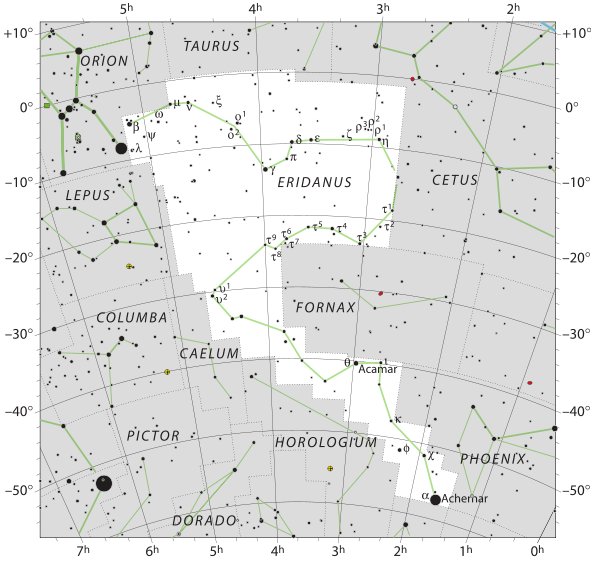 |
|
OCT 1 (91 + 183): |
*25 |
SEPT 6 (66 +
183): |
*192 |
Nov 18
(322): |
6 |
Nov 25 (329): |
|
APRIL 1 (91) |
MARCH 5 (66) |
322 - 41 -
80 = *201 = "Oct 8 (281) |
329 - 41 - 80 = *208 = "Oct 15
(288) |
|
June 4 (91 + 64 =
155) |
May 12 (130 = 66 +
64) |
|
 |
 |
 |
 |
|
Ba1-1 |
Bb3-25 (414
+ 110) |
Bb3-34 (112 +
421) |
Bb3-41 (3 * 180) |
|
HAEDUS II (*75) |
ALGENIB PERSEI
(*50) |
ρ Cor. Borealis
(*242.4) |
ANTARES (*249) |
|
"April 24 (114 =
91 + 23) |
"March 30 (89 =
66 + 23) |
"Oct 8 (281) |
"Oct 15 (288) |
there appears to have emanated a kind of Cosmic String Theory:
...
string games could be resumed after it was clear that
the Sun had managed to leave the horizon and was rapidly
gaining in altitude: 'Before the sun starts to leave the
horizon ... when it shows only on the horizon ... then
string games were no longer allowed as they might lacerate
the sun. Once the sun had started to go higher and could be
seen in its entirety, string games could be resumed, if one
so wished. So the restriction on playing string games was
only applicable during the period between the sun's return
and its rising fully above the horizon ...
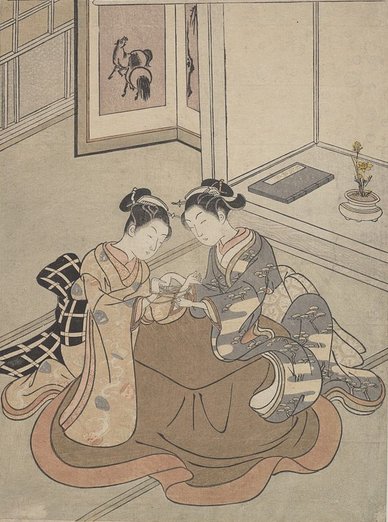
|















.jpg)












